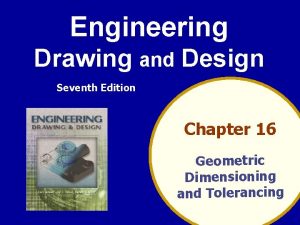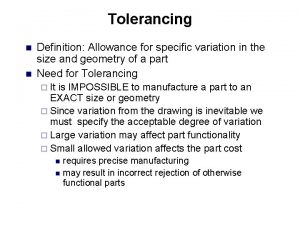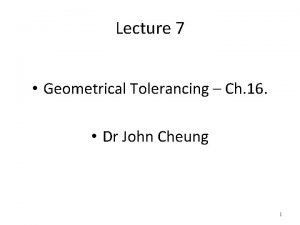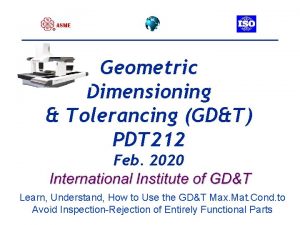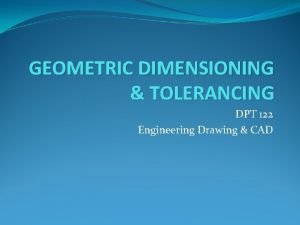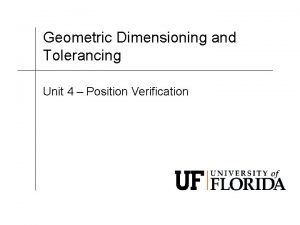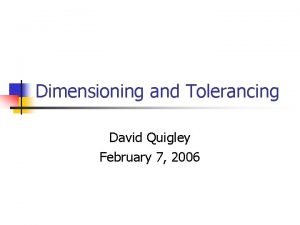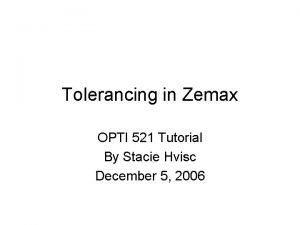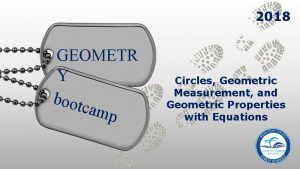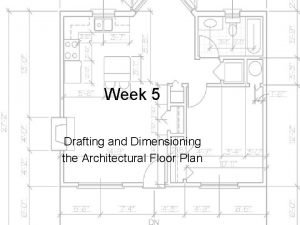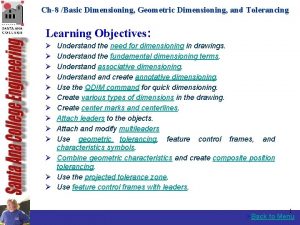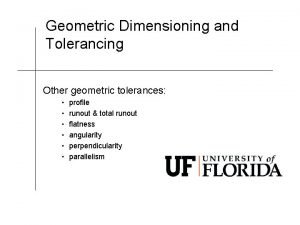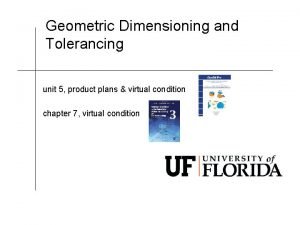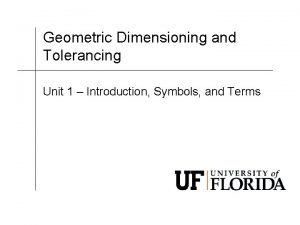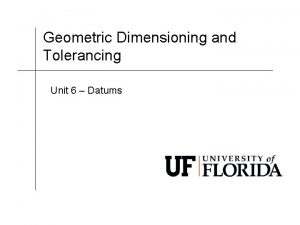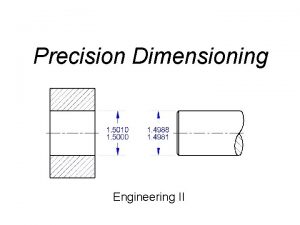Geometric Dimensioning and Tolerancing Unit 2 Limits of














- Slides: 14

Geometric Dimensioning and Tolerancing Unit 2 – Limits of Size

Overview of Rules • There are four general rules 1. Taylor’s rule. Limits of size. 2. Regardless of Feature Size (RFS) is the default. 3. Pitch cylinder axis is reference for thread and screws. 4. Virtual condition. EML 2023 Department of Mechanical and Aerospace Engineering 2

Rule 1 – Taylor’s Principle • Rule 1 states*: – "where only a tolerance of size is specified, the limits of size of an individual feature prescribe the extent to which variations in its geometric form, as well as size, are allowed. “ • The feature surface may not exceed the limits of size. • When a feature is made at MMC, it must be of perfect form. • When not at MMC, the shape may not extend beyond the MMC perfect form. * William Taylor, 1905 EML 2023 Department of Mechanical and Aerospace Engineering 3

Rule 1 • If made smaller than MMC, the peg can be bent or tapered. • However, it must not extend beyond the MMC perfect shape boundaries. EML 2023 Department of Mechanical and Aerospace Engineering 4

Limits of Size – Rule #1 Taylor Principle (1905) The limits of size “Rule #1” defines the size and form limits for regular, individual features. It requires perfect form at MMC and ensures the pin will fit in the hole. If the feature is made at MMC, its form must be perfect.

Limits of Size – Rule #1 (Envelope Principle, Taylor Principle) The limits of size define the size, as well as the form of an individual feature. The form of the feature may vary within the size limits. If the feature is produced at its maximum material condition, the form must be perfect. The feature may be bent, tapered or out of round as it departs from the maximum material condition.

Limits of Size – Rule #1 (Envelope Principle, Taylor Principle Verification Check #1 (form or shape check) The limits of size define the size, as well as the form of an individual feature. The form of the feature may vary within the size limits. If the feature is produced at its maximum material condition, the form must be perfect. The feature may be bent, tapered or out of round as it departs from the maximum material condition.

Limits of Size – Rule #1 (Envelope Principle, Taylor Principle Verification Check #2 (local size check) The limits of size define the size, as well as the form of an individual feature. The form of the feature may vary within the size limits. If the feature is produced at its maximum material condition, the form must be perfect. The feature may be bent, tapered or out of round as it departs from the maximum material condition.

Limits of Size – Rule #1. 874. 870 This on the drawing Means this . 870 Min . 874 Max Can be waisted within. 004. Form can be refined with straightness or cylindricity. Can be tapered within. 004 Form can be refined with cylindricity. . 870 Min . 874 Max Can be bent within. 004. Form can be refined with straightness or cylindricity. . 874 Max. 870 Min Can be “D” shaped out of round within. 004 Form can be refined with circularity or cylindricity. Can be barreled within. 004 Form can be refined with straightness or cylindricity. . 874 Max. 870 Min Can be oval or out of round within. 004 Form can be refined with circularity or cylindricity.

Rule 1 • Also, rule 1 does not control any interrelation of features. The outer and inner surfaces each obey rule 1 individually. EML 2023 Department of Mechanical and Aerospace Engineering 10

Limits of Size – Rule #1 Does Not Control the Relationship Between Features Produced part with error The center of the part is vague and not clear. This manufactured shaft has 4 centers. A Datum Reference Frame has not been established. 2. 10

Rule 2 – RFS default • Regardless of Feature Size (RFS) applies, with respect to the individual tolerance, datum reference, or both, where no modifying symbol is specified. • This will be discussed further with regards to MMC and LMC modifiers. EML 2023 Department of Mechanical and Aerospace Engineering 12

Rule 3 - threads • Rule Three applies to all screw threads, gears, and splines. • "for each tolerance of orientation or position and datum reference specified for screw threads applies to the axis of the thread derived from the pitch cylinder, for gears and splines, the MAJOR DIA. , PITCH DIA. , or MINOR DIA. must be specified. " EML 2023 Department of Mechanical and Aerospace Engineering 13

Rule 4 – datum/virtual condition rule • applies to datum features subject to size variation • "depending on whether it is used as a primary, secondary, or tertiary datum, a virtual condition exists for a datum feature of size where its axis or center line is controlled by a geometric tolerance. “ • virtual condition is the worst acceptable condition of a feature • the virtual condition for an internal or external feature is the LMC size EML 2023 Department of Mechanical and Aerospace Engineering 14
 Geometric dimensioning and tolerancing
Geometric dimensioning and tolerancing Limits involving infinity asymptotes
Limits involving infinity asymptotes Histogram polygon graph
Histogram polygon graph Circularity vs roundness
Circularity vs roundness Coordinate tolerancing
Coordinate tolerancing Tolerancing
Tolerancing Tolerancing
Tolerancing Feature control frame
Feature control frame Tolerancing
Tolerancing Tolerancing
Tolerancing Zemax demo
Zemax demo Circles geometric measurement and geometric properties
Circles geometric measurement and geometric properties Unit 10, unit 10 review tests, unit 10 general test
Unit 10, unit 10 review tests, unit 10 general test Wall thickness in floor plan
Wall thickness in floor plan Baseline dimensioning definition
Baseline dimensioning definition
